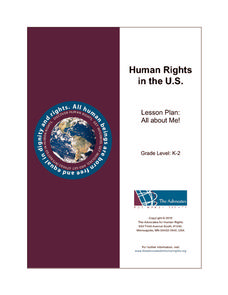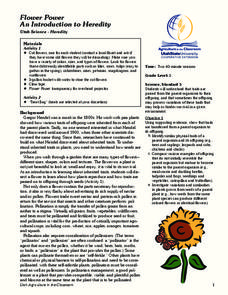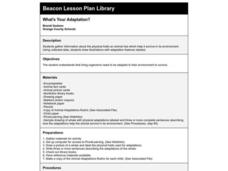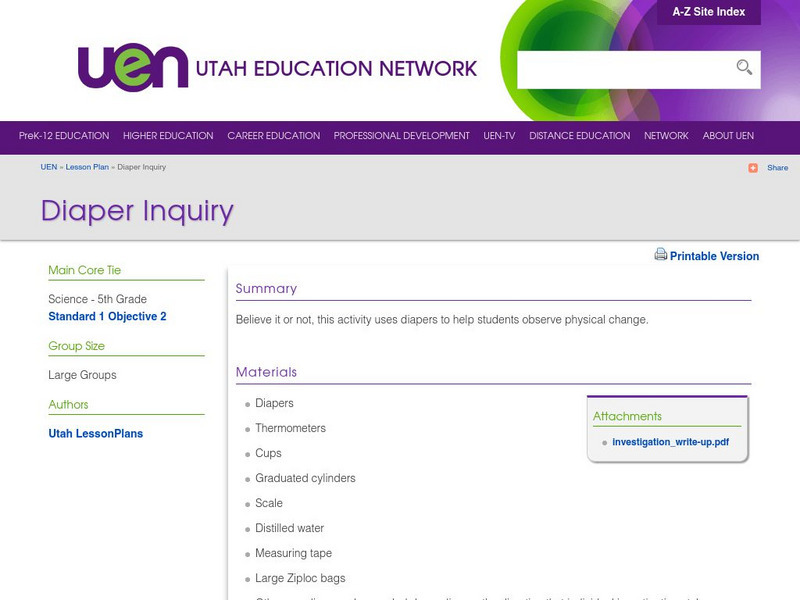Illustrative Mathematics
Sort and Count II
Capture the engagement of young mathematicians with this hands-on sorting activity. Given a bag of objects, students work independently sorting the items based on their physical attributes, counting to determine the size of each group....
Curated OER
Families and Heredity
Personality traits and physical appearance traits within families are the focus here. Learners make a poster which lists the shared physical traits they have with their family. Peers look at each poster and write down the traits they see...
Curated OER
All About Me
Students identify personal traits. In this autobiographical art lesson, students read the book Whoever You Are and use art supplies to create a body cut-out of themselves. Students include physical characteristics on their cut out.
Curated OER
Special Traits: Alabama quarter reverse
Who knew a state quarter could say so much? Alabama's quarter is embossed with an image of Helen Keller, pupils will use this image to think about what the phrase "Spirit of courage" means. They will use a graphic organizer to...
Wordpress
Access (1st Year) Pen Pal Format
Help young writers make a good first impression on their pen pals with this personal letter template. Including sentence frames and word banks, this resource supports children as they learn to write personal descriptions using complete...
Curated OER
Rock, Paper, Scissors
Fifth graders explore genetic traits. In this genetic traits lesson, 5th graders investigate dominant and recessive traits. Students identify similar traits between a parent organism and its offspring.
Curated OER
Flower Power: An Introduction to Heredity
Young scholars observe flowers and how they grow according to heredity. In this flowers lesson plan, students observe physical traits that make flowers the offspring of other flowers, and fill out worksheets according to their findings.
Curated OER
Traits
Sixth graders consider heredity. In this science lesson plan, 6th graders gain an understanding of certain physical traits are inherited from their parents through the genes.
Curated OER
What's Your Adaptation?
Second graders gather information about the physical traits an animal has which help it survive in its environment. Using collected data, 2nd graders draw illustrations with adaptation features labeled.
BBC
Bbc Languages: Talk Age and Siblings
This site is focused on the context of talking about the family and includes a video and a worksheet. This video explores the vocabulary and structures of family, age, marriage and family celebrations. The grammar areas of focus are on...
BBC
Bbc: Languages Spanish: Talk Spanish Your Age Worksheet
Students will learn how to ask and answer questions about someone else's family with this learning module. Video clips of native Spanish speakers provide context for each question and statement about each of their families.
Concord Consortium
Concord Consortium: Geniversity for Geniverse
Geniversity has been designed to help teachers use Geniverse, free web-based software for high school biology that engages students in exploring genetics by breeding and studying virtual dragons.
Writing Fix
Writing Fix: Your Glorious Gene Pool
Young scholars read the books like I Am the Dog. I Am the Cat by Donald Hall and Joyful Noise by Paul Fleischman and read the lyrics while listening to the song "Shallow End of the Gene Pool" by the Austin Lounge Lizards. Then students...
TES Global
Tes: Character Analysis
[Free Registration/Login Required] A downloadable graphic organizer for analyzing a character is provided on this page.
Read Works
Read Works: Inheritance of Traits
[Free Registration/Login Required] An informational text about learned and inherited traits. A question sheet is available to help students build skills in reading comprehension.
Read Works
Read Works: Kindergarten: Character: Lesson 1: Physical Attributes of a Character
[Free Registration/Login Required] A lesson plan, based on David McPhail's Lost!, in which students are introduced to literary characters and explore the various clues, such as descriptions and illustrations, that communicate a...
Utah Education Network
Uen: Diaper Inquiry
Learners investigate the technology of a diaper. They consider various physical traits of a diaper and then come up with an investigation to test some of these traits.
NumberNut
Number Nut: Identifying Traits
Investigate the relationship between shapes and identifying traits or characteristics. A concise lesson that explores physical, chemical, and observable traits in the shapes around us. Build on this knowledge by playing the Web Colors...



















